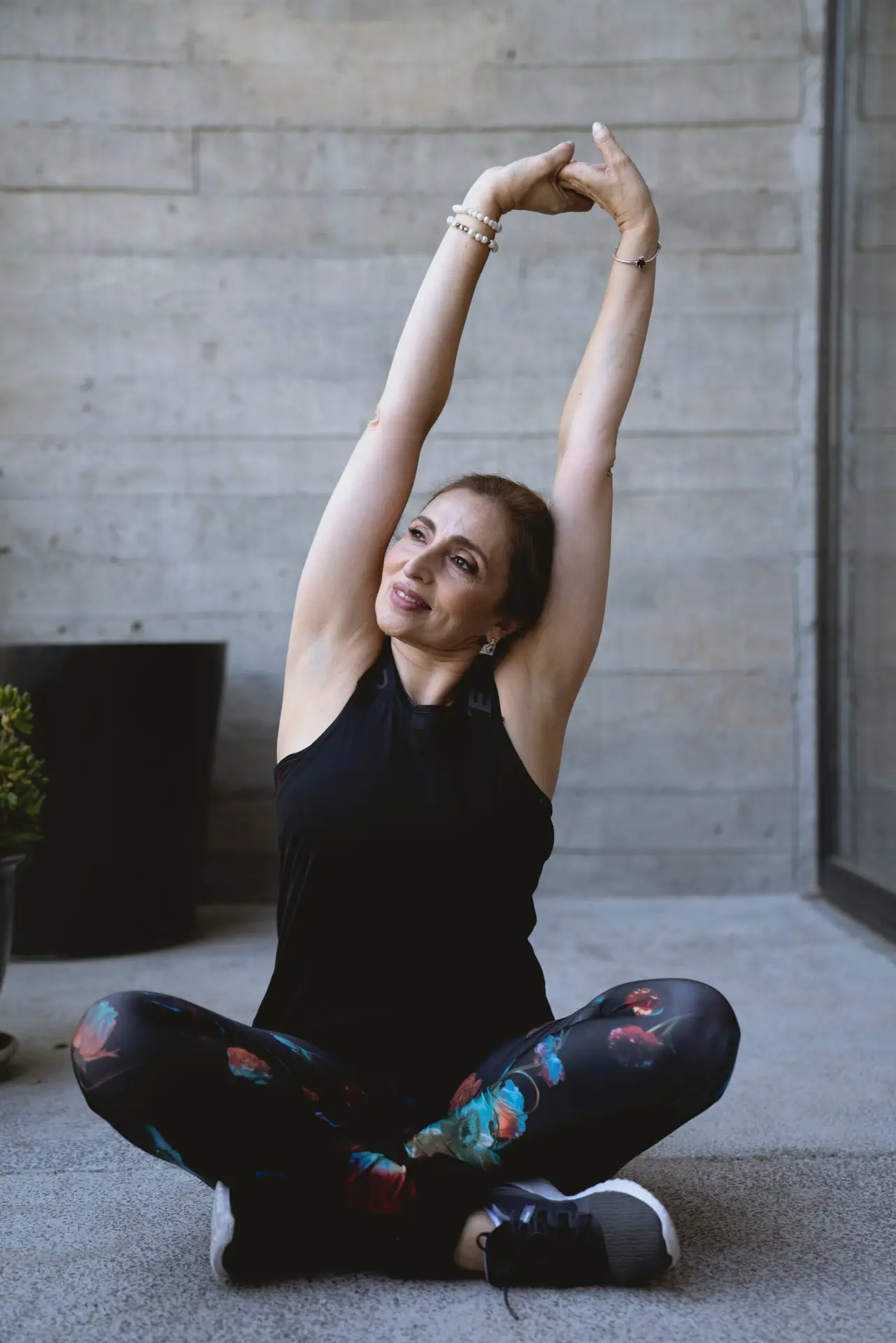We all know that exercise is important for our bodies to stay healthy and happy, especially as we age. However, finding a good exercise routine that is gentle enough for seniors, but keeps your body healthy and moving, can be a real challenge. Below are six morning exercises for seniors that are easy to mix into your morning routine. Regular exercise and stretching can improve range of motion, stability, and all around mental health.
Why Exercise For Older Adults is Important
Exercising helps to slow the progression of many diseases and can even slow the aging process. Studies have shown that older adults, those age 55+, who have been active for most of their lives actually have the similar aerobic fitness of people 30 years younger than them.
For older adults who have not been able to stay active their whole life, it’s not too late to start. Starting now will help not just in the long-term, but there are also plenty of short-term benefits to exercises for seniors.
Exercise is essential in managing many long-term health conditions such as heart disease, diabetes, asthma, or back or joint pain. For example, exercise can help improve high blood pressure and can lower your risk of heart disease progression.
Daily Exercises for Seniors
This exercise routine is meant to be versatile and flexible. Do the exercises that feel the best for you and your unique needs. As you make the routine your own, be sure to start slowly and stop if there is any bad pain.
Make sure you have a clear space with plenty of room to move your arms and legs. A chair, water bottle, and towel may also be helpful to have close to you.
Also, always start with some nice stretches to get you going.
Sit to Stand
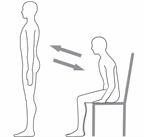
The sit-to-stand exercise is among one of the best exercises for seniors. It strengthens your lower body and can improve general mobility, and helps make standing up from a chair easier. Eventually, as your strength improves, the goal is to do the sit-to-stand exercise without using your hands.
It is normal to feel mild stretching, pulling, tightness, or discomfort as you do this exercise, but you should stop right away if you feel pain.
How to do the exercise:
- Sit on a sturdy chair. Your knees should be bent and your feet should be flat on the floor and shoulder-width apart.
- Place your hands lightly on each side of the seat. Keep your back and neck as straight as possible, with your chest slightly forward.
- Breathe in slowly. Lean forward and slightly shift your weight to the front of your feet.
- Breathe out as you slowly stand up. Try to use as little support from your hands as possible.
- Stand and pause for a full breath in and out.
- Breathe in as you sit down slowly. Tighten your core and abdominal muscles to control your lowering as much as possible.
- Breathe out slowly.
- Rest for 1 minute, then do another set of 5-8 repetitions. Repeat for a total of 3 sets if comfortable.
Knee Extensions
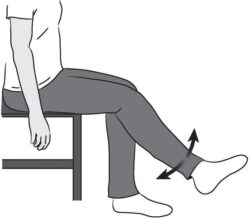
Knee extension exercises are used to strengthen thigh muscles. These are big muscles in our body and improving thigh muscle strength can improve mobility, reduce knee injury risk, and rehabilitate knee injuries.
How to do the exercise:
- Sitting up tall with your shoulders back and down.
- Lifting one leg up, extending at the knee.
- Hold briefly at the top of the movement, squeezing the muscles at the front of the thigh before lowering your leg back down.
- Ensure the movement is slow and controlled.
- Alternate legs, ensuring full knee extension (leg completely straight).
- Rest for 1 minute, then do another set of 5-8 repetitions. Repeat for a total of 3 sets if comfortable.
Core twists
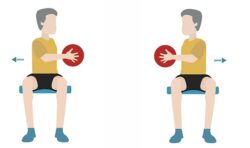
Cores twists are a fantastic exercise that not only improve the strength of your trunk muscles, including back and ad muscle, but they also help with twisting mobility.
How to do the exercise:
- Grab a medicine ball (or similar object).
- Sit comfortably in the chair toward the edge of the seat for extra room. Keep the core (abs and lumbar) tight. Stick the chest out. Both hands should be in front of the body gripping the sides of the medicine ball, with elbows bent.
- Lift the ball a couple inches off the lap then rotate the upper body to the right, keeping the ball in front of the body.
- Rotate to the middle of the body then rotate to the left, finish by rotating back to the middle.
- Each “rep” is one full rotation.
- Rest for 1 minute, then do another set of 5-8 repetitions. Repeat for a total of 3 sets if comfortable.
Seated Shoulder Press
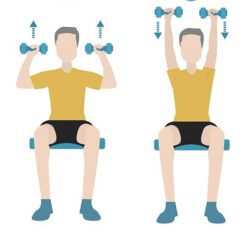
This exercise will help to increase strength and mobility of the shoulders. Please be cautious with this exercise if you have any shoulder contraindications, and/or consult with your physician.
How to do this exercise:
- Choose a pair of low weight dumbbells or do without weights.
- Sit comfortably in the chair with the hips as far back as possible. Ensure that the back is firm to the backrest of the chair.
- Keep your core tight.
- Start with both elbows spread to the sides of the body and align them under the shoulders. Stick the chest out.
- Face the body straight, palms forward, gripping the dumbbells.
- Extend the arms up, reaching above the head until they’re fully extended (or get to a range that feels most comfortable). Don’t touch the hands together and keep both arms parallel to each other.
- Once the arm’s extension limit has been reached, slowly bring the hands down to the starting position, keeping the elbows spread. Don’t tuck the elbows toward the middle of the body, extend them out till the top of the back feels a pinching sensation (not hurting) at the shoulder blades.
Seated Knee Lifts
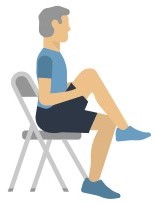
Knee lifts exercise and strengthen the hip flexors, and quads. Each is an important muscle for sitting and standing.
How to do the exercise:
- Sit on a sturdy chair, keeping the back straight and holding the sides for support if needed. Avoid leaning back.
- Slowly lift the right knee slowly towards your chest, then back to the beginning position with control.
- Repeat the motion using the left leg.
- Alternate the legs. Remember to keep your back straight and avoid leaning back to gain new heights.
Seated Chest Press
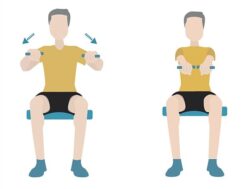
The seated chest press will exercise your chest muscles, shoulders, and triceps.
How to do the exercise:
This exercise can be done with a resistance band, dumbells or with no weight all. Choose the option that best meets your fitness level.
- Place the resistance band/weights/or empty fists at a point on the chair where it’s directly behind the back just under where the shoulder blades would be. Ensure that the resistance band isn’t able to move on the back of the chair; moving it during the exercise can result in injury or target the wrong muscle groups.
- Sit comfortably in the chair with the hips as far back as possible. Ensure that the back is firm to the backrest of the chair.
- Keep the core muscles tight. Stick your chest out.
- Keep both palms down, elbows bent and parallel to the shoulders. Both hands should be positioned just outside of shoulder width.
- Push the resistance band forward until the arms are fully extended in front of the body (don’t touch hands together).
- Slowly reverse the movement back to starting position.
Some General Tips
Remember, starting a new exercise routine will take some practice and “getting used to.” Don’t get discouraged if you can’t do an exercise or can only do a few repetitions.
Here are few things that are normal when starting a new exercise regimen. It’s normal to:
- feel tired when starting an exercise routine.
- have muscle soreness that lasts a few days. As you get stronger, you may not feel muscle soreness.
Here are some tips that can help make your new exercise journey easier:
- Use smooth, steady movements.
- Do not hold your breath during strength exercises. This can cause unsafe changes in your blood pressure.
- Breathe in slowly through your nose, and breathe out slowly through your mouth.
Most importantly, Always consult with a physician before beginning any exercise program.
Keeping Seniors in Their Homes, It’s What We Do.
At Senior LIFE, we focus on taking care of the whole person so that they can maintain their independence for as long as possible. We offer various types of therapy for members. Depending on members’ individual care plans, they may receive any or all of the therapies we offer.
- Occupational Therapy
- Physical Therapy
- Speech/Language Therapy
- Recreational Therapy
We are committed to keeping members independent as long as possible. There are no limits on rehabilitation or the amount of therapy services a member can receive.
Our care offerings don’t stop at therapies. We also offer all the medical and supportive services our members need. These services can include physicians and specialists, nursing care, physical, occupational and speech therapies, personal and home care, medications, meals and nutritional counseling, eye, dental and foot care, durable medical equipment and other medically necessary services.
The LIFE Program is a Medicare and Medicaid approved long-term care program that provides complete medical care and supportive services for persons 55 years and older so that they can remain living in their home. The LIFE Program is an alternative to nursing and personal care homes. https://seniorlifepa.com/about
To learn more about the LIFE Program, or to see if it’s the right fit for you and your loved ones, contact us today! https://seniorlifepa.com/contact

